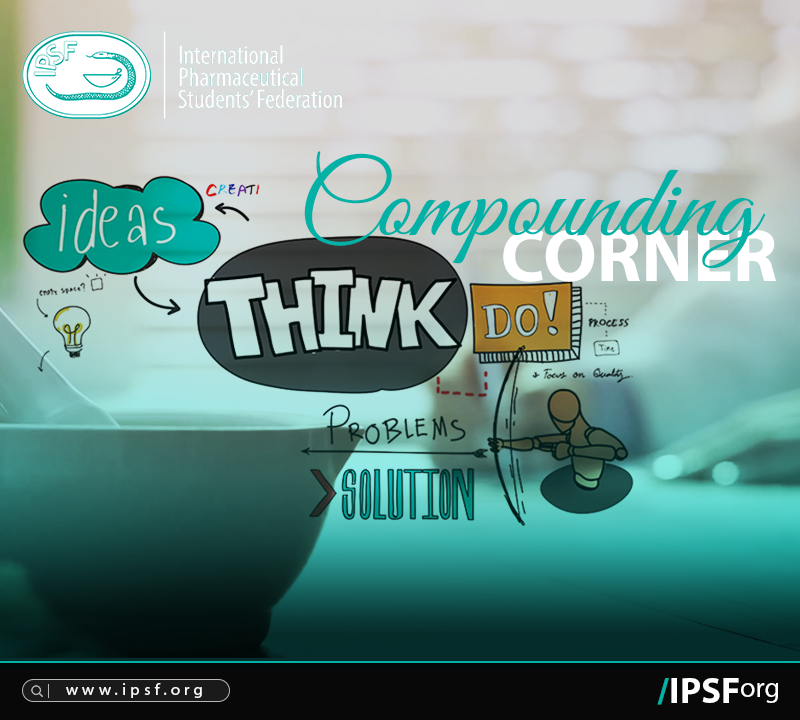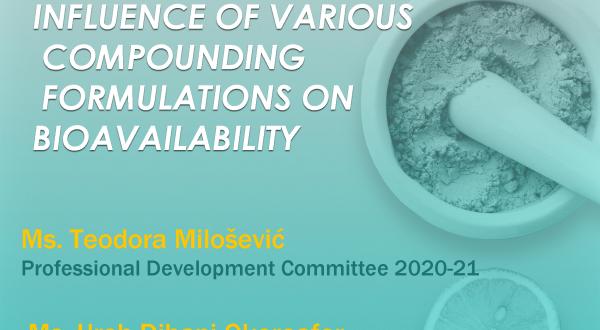
Compounding Corner - December 2018
Introduction to Compounding
As a hospital pharmacist, what are you supposed to do after receiving prescription from a doctor?
The pharmacy profession covers various roles as in manufacturing, compounding, quality control of pharmaceutical preparations, storage and distribution, and development of drugs, among others. Being knowledgeable in these sectors is the cornerstone of a competent pharmacist. In this article, we will expound on one of these roles - compounding.
Aspects of Compounding
To properly perform compounding, a pharmacist must consider several aspects, namely:
1. Administrative Aspect
The administrative aspect relates to prescriptions. In here, pharmacists check on the administrative completeness of the prescription, particularly: Date, Patient's Information, International Statistical Classification of Diseases and Related Health Problems, Doctor's Name and Signature, Inscription, Subscription, and Directions for Use.
2. Pharmaceutical Aspect
The pharmaceutical aspect covers safety, effectiveness, and stability of the drug and acceptance of the drug by the patient.
3. Clinical Aspect
The clinical aspect encompasses drug indications, effectiveness, safety, and compatibility of dosage forms, and review of patient compliance.
General Steps in the Compounding Process
Preparation phase:
1. Receiving and checking for completeness and authenticity of the recipe.
2. Clarifying with the doctor or patient about any missing information.
3. Calculating drug dosages and checking for drug interactions.
4. Calculating the amount of drugs and excipients to be used.
5. Maintaining proper hygiene and the cleanliness of the compounding area.
Compounding phase:
6. Dispensing all the necessary ingredients.
7. Careful review of the ingredients.
8. Compounding based on the appropriate technique.
Final Phase:
9. Checking for indication, weight variation, and homogeneity of formulation made.
10. Logging of information in compounding books.
11. Labeling of the prepared drug.
12. Cleaning of both compounding and storage areas.
13. Giving (dispensing) medication to patient.
Problems that often occur in compounding
When compounding, pharmacists often encounter several problems, which can be categorized into five:
1. Quality Problems
These involve the temperature and humidity of the room influencing the stability of the drug, the readiness of pharmacy personnel in conducting compounding, particularly the wearing of personal protective equipment as in laboratory coats, masks, and gloves. In addition, the cleanliness of equipment used and the presence of contamination are other factors that cause problems in compounding.
2. Calculation Problems
These involve problems related to the computation of suitable doses, amount of drugs and excipients to be weighed, and appropriate dilution.
3. Dosage Form Problems
These problems are encountered with drugs having varying dosage strengths within the dosage form. For example, a drug in the form of coated tablet, such as delayed-release or sustained-release, cannot be crushed to obtain a smaller dose as doing so will damage the existing matrix system.
4. Stability Problems
These problems encompass those which are related to drug storage, drug packaging, and special treatments/mixing techniques. An example is the mixing of menthol and camphor, which can cause a decrease in melting point (eutectic point).
5. Incompatibility Problems
These are problems of serious consideration by pharmacists, which may fall under the following categories:
- physical incompatibility: an example of which is color change
- chemical incompatibility: as seen in drug degradation
- pharmacological incompatibility: which is an incompatibility that results to toxicity
Introduction to dosage forms that will be discussed on the compounding corner over the next few months
1. Compounding of Oral and Topical Powders (January 2019)
Oral powders such as pulvis, capsules, and topical powders will be discussed in this section. Pulvis (powder) is a dry mixture of mashed medicinal or chemical ingredients intended for oral or external use, whereas capsules are solid preparations consisting of drugs in hard or soft shells.
2. Compounding of Rectal and Vaginal Preparations (February 2019)
Rectal preparations/ suppositories are solid preparations in various weights and shapes, which are administered through the rectal route, whereas vaginal preparations or ovules are solid preparations administered through the vagina.
3. Compounding of Ointments and Pastes (March 2019)
An ointment is a semi-solid preparation intended for application on the skin, while a paste is an ointment containing more of the solid content.
4. Compounding of Gels and Creams (April 2019)
A gel is an ointment containing more of the water content trapped in a matrix. In comparison, a cream is a semi-solid preparation in the form of emulsion containing one or more dissolved or dispersed drugs in the base material, suitable and generally intended for external use.
5. Compounding of Oral Liquids and Drops (May 2019)
An oral liquid is a liquid preparation containing one or more dissolved chemicals intended for administration by mouth. Drops, on the other hand, are liquid preparations in the form of solutions, emulsions or suspensions, which are intended for internal use and are administered with a dropper.
6. Compounding of Suspensions and Emulsions (June 2019)
A suspension is a liquid preparation containing dispersed, insoluble solid particles in the liquid phase, whereas an emulsion is a two-phase system in which one of the liquids is dispersed in another liquid in the form of small droplets.
7. Compounding of Topical Liquids and Guttae (July 2019)
Topical liquids are solutions used for application on the skin, whereas guttae are liquid preparations similar to drops but are specifically used as external medicine.



